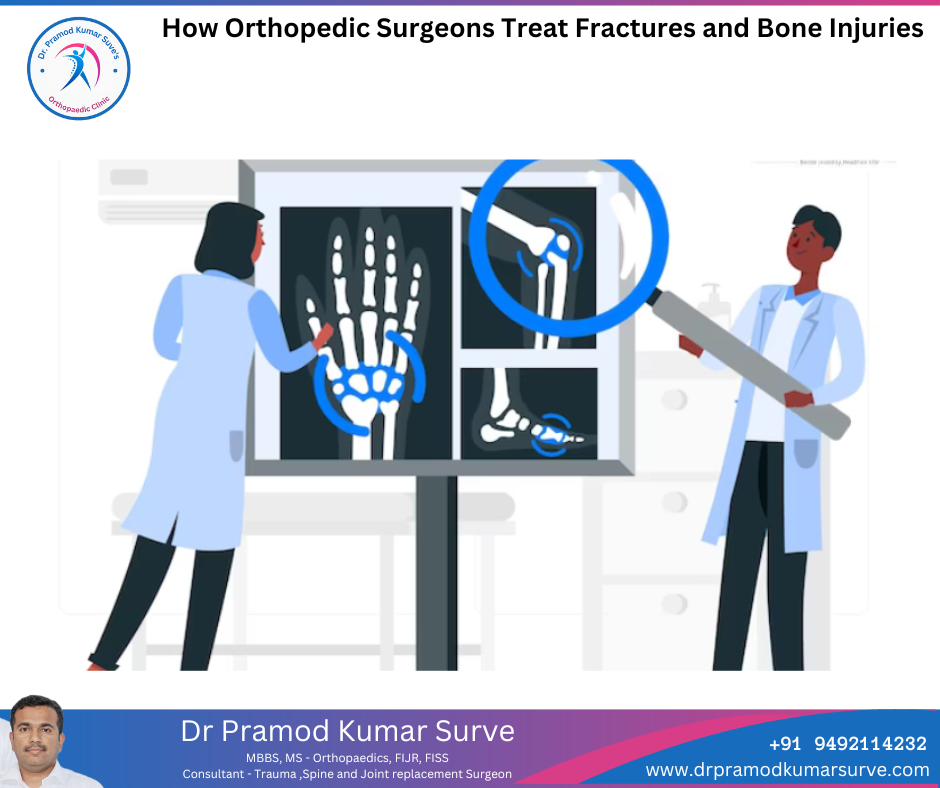Introduction:
Fractures and bone injuries are common occurrences that can significantly impact a person’s mobility and quality of life. In such cases, the expertise of orthopedic surgeons becomes crucial. These skilled medical professionals possess the knowledge and experience necessary to effectively treat fractures and bone injuries, providing patients with the best possible outcomes. In this blog post, we delve into the realm of orthopedic surgery and gain insights from the esteemed orthopedic surgeon, Dr. Pramod kumar from Pune.
Meet Dr. Pramod Kumar:
Orthopaedic surgeons are medical doctors who specialise in the diagnosis, treatment, and prevention of injuries and disorders of the musculoskeletal system, which includes bones, joints, ligaments, tendons, and muscles. If you are looking for an orthopaedic surgeon in Hadapsar who specialises in spine-related issues, you may want to consider Dr. Promod Kumar Surve.
How to Diagnose?
When a patient presents with a suspected fracture or bone injury, the first step is an accurate diagnosis. Dr. Pramod kumar emphasizes the importance of a thorough examination, which may include physical evaluations, imaging tests such as X-rays or MRIs and detailed discussions with the patient about their symptoms and medical history. This comprehensive approach helps in determining the type, severity, and location of the fracture or injury.
Treatment Options:
-
Non-Surgical Treatment:
- Immobilization: In cases where the fracture is stable and unlikely to shift, immobilization with a cast, splint, or brace may be sufficient. This allows the bone to heal naturally over time.
- Medications: Pain management is an essential aspect of treatment. Dr. Pramod kumar may prescribe pain-relieving medications or recommend over-the-counter options to alleviate discomfort.
-
Surgical Intervention:
- Open Reduction and Internal Fixation (ORIF): In more severe fractures, surgery may be necessary. ORIF involves aligning the broken bone fragments and securing them with screws, plates, or rods to facilitate proper healing.
- External Fixation: This technique involves placing metal pins or screws into the bone above and below the fracture site. However these are connected to an external frame, which stabilizes the bone during the healing process.
- Intramedullary Nailing: This procedure involves inserting a metal rod into the medullary canal of a long bone to stabilize the fracture and promote healing.
Recovery and Rehabilitation:
The recovery get begins after surgery or non-surgical treatment of any patient. Dr. Pramod kumar highlights the importance of a comprehensive rehabilitation program to optimize healing and restore functionality. This may include physical therapy exercises, range-of-motion activities, and strength training tailored to the individual needs of the patient. Regular follow-up visits allow the orthopedic surgeon to monitor progress and make any necessary adjustments to the treatment plan.
Conclusion:
While suffering from fractures and other bone injuries can be physically and psychologically taxing, patients can take comfort in knowing that they are in skilled hands. From accurate diagnosis to personalized treatment plans, orthopedic surgeons play a vital role in helping individuals regain their mobility. If you ever find yourself dealing with a fracture or bone injury, consult a qualified orthopedic surgeon. They can guide you through the healing process and help you regain your strength.
Disclaimer: The medical information in this blog post is provided as an informational resource only and should not be considered a substitute for professional medical advice, diagnosis, or treatment. Please consult a qualified healthcare provider for any specific concerns or questions regarding your health.
